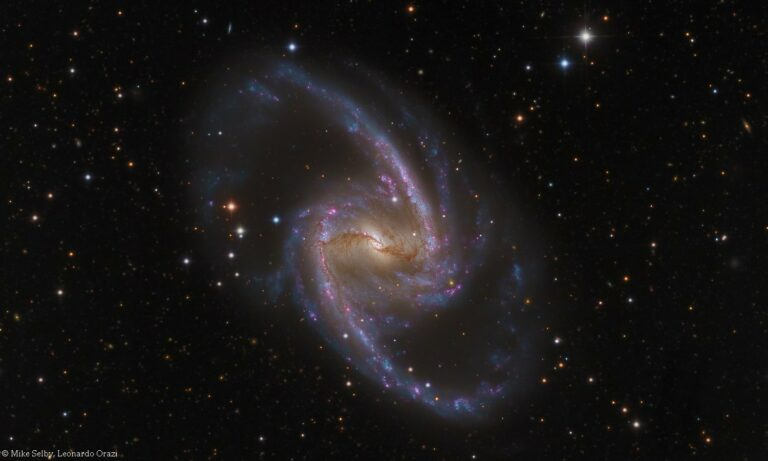The barred spiral galaxy NGC 1365 seen by the Webb telescope

Located about 56 million light-years away in the southern constellation of the Furnace, the barred spiral galaxy NGC 1365 spans some 200,000 light-years from side to side, i.e. two times the size of our own Milky Way galaxy. Just 60 million light-years away. This image taken by the James Webb Space Telescope's Mid Infrared Instrument (MIRI) reveals superb detail in infrared light. This field extends about 60,000 light-years across NGC 1365, exploring the galaxy's core and very bright new-born stars. These young stars have spawned an inextricable network of filaments and dust bubbles that stretches from the central bar of the galaxy to the spiral arms.
Southern sky:
The barred spiral galaxy (read the definition ) NGC 1365 was discovered in 1826 by James Dunlop. This Scottish astronomer was then in Australia where he assisted Governor Thomas Brisbane in his private observatory. That year, Dunlop also discovered the star cluster NGC 602 . The magnitude of 9.6 that is attributed to this beautiful "island universe" (the name that the philosopher Immanuel Kant gave to galaxies), reserves NGC 1365 for powerful telescopes. Recall that the acronym NGC refers to the imposing New General Catalog of Nebulae and Clusters of Starswhich includes nearly 8,000 deep sky objects. Initiated by the Irish-Danish astronomer John Dreyer, this catalog was the subject of a first edition in 1888.

NGC 1365 is an elegant barred spiral galaxy.
Cosmic celebrity:
Many instruments are studying NGC 1365. From the National Science Foundation telescopes to those of ESO , they all seek to reveal new details in this barred spiral galaxy. Astronomers measure a very high rate of star formation there, which is revealed by the general bluish color. A phenomenon which is explained by the presence of an enormous bar (composed of old stars and dust) which connects the two spiral arms. By compressing the gas present, this bar triggers multiple stellar births in the arms of the galaxy.
NGC 1365 contains a black hole at its center that is around two million solar masses. It is important but not exceptional, if we remember that the black hole in Messier 87 has a mass of about 6.5 billion solar masses!
Source : websites

